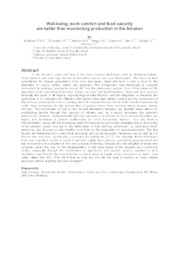Well-being, work comfort and food security are better than maximizing production in the Amazon.
Well-being, work comfort and food security are better than maximizing production in the Amazon.
Author(s): BARBOSA, T. M. F.; TOURRAND, J. F.; NAHUM, B. S.; VEIGA, J. B. da; QUANZ, D.; SIST, P.; SCOPEL, E.; HOMEM, V. S. F.
Summary: In the Amazon, slash and burn is the most common technique used by American-Indians, small farmers and even big ranches to transform forests into rural landscapes. The basis of food subsistence for diverse populations (rice, corn and bean), slash and burn is also a must for the plantation of cocoa, coffee, palms and pastures. The Amazonian rural landscape is currently dominated by pastures, occupying around 80 % of the deforested surface. Even if the nature of the plantation varies according to location, height, soil type and local traditions, slash and burn remains relatively the same in all regions. Agro-ecological intensification and the integration of livestock and agriculture is 2-3 decades old. Different alternatives have been tested, particularly the introduction of leguminous (covering the land or forming trees) to improve the soil and to build a bank of proteins for cattle. New techniques for the recuperation of pasture lands have become widely popular among ranches. The introduction of one or two annual plantations between two pasture areas allows reestablishing fertility through the injection of nitrates and, as a result, increases the pasture?s productivity. However, being relatively high-cost because of its demand in terms of mechanization and inputs, this technique is almost unaffordable for small Amazonian farmers...
Publication year: 2008
Types of publication: Paper in annals and proceedings
Unit: Embrapa Eastern Amazon
Keywords: Agroecologia, Amazonia
Observation
Some of Embrapa's publications are published as ePub files. To read them, use or download one of the following free software options to your computer or mobile device. Android: Google Play Books; IOS: iBooks; Windows and Linux: Calibre.
Access other publications
Access the Agricultural Research Database (BDPA) to consult Embrapa's full library collection and records.
Visit Embrapa Bookstore to purchase books and other publications sold by Embrapa.

